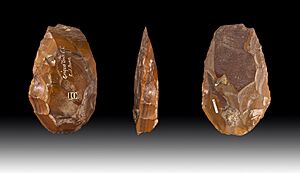History of the Northern Cape facts for kids
The Northern Cape is a large and special part of South Africa. It became a clear, separate area in the 1940s. Back then, people started a group called the "Northern Cape and Adjoining Areas Regional Development Association." This was also when the first map showing the name "Northern Cape" was made.
But the exact borders of the Northern Cape weren't set until 1994. That's when it officially became the Northern Cape Province. This was one of South Africa's nine new provinces after apartheid ended. Since then, some small changes have been made to its borders. For example, parts of what used to be Bophuthatswana (near Kuruman and Hartswater) were added from the North West Province. However, places like Vryburg and Mafikeng, which were once thought of as part of the "Northern Cape," are now in the North West Province.
A true History of the Northern Cape would mostly cover the time since 1994. But the different regions that now make up the Northern Cape share some important stories. Historian Nigel Penn called it The Forgotten Frontier in South African history. This area's past is very important because it led to big changes in the whole country. These changes included finding lots of diamonds and other minerals, which led to factories and new ways of working. Many people became migrant workers, living in special compounds or hostels. Cities grew, and unfortunately, there was also a system of racial separation. All these changes together are known as the mineral revolution in South Africa.
Contents
Ancient History of the Northern Cape
The central plateau of South Africa is very special. It was home to many people who didn't farm but were amazing at making stone tools, even until quite recently. Experts say that South Africa has more Stone Age remains than almost anywhere else on Earth!
For a long time, many people didn't know this because of how history was taught during apartheid. Professor N.J. van der Merwe, an archaeologist, once said that looking at South African history as it was taught was like "looking at human events through the wrong end of a telescope."
Important ancient sites in the Northern Cape include Wonderwerk Cave near Kuruman, Canteen Kopje near Barkly West, and a group of sites at Kathu. There's also the Wildebeest Kuil Rock Art Centre near Kimberley, and many rock art sites in the ǀXam and ǂKhomani heartland in the Karoo. You can also find old stone-walled ruins at Dithakong, northeast of Kuruman.
Conflicts and Big Changes
When European settlers arrived, it made conflicts worse among the different groups already living in the Northern Cape. Groups like the Griqua, Baster, and Korana got access to better weapons, like firearms and horses. This made them stronger, and they formed fighting groups to raid the San people's animals and lands.
Over time, these events led to a very difficult period for the San people. For example, when it was found that merino sheep could live in the Bushmanland, more herders wanted to move onto San land. New technology, like boreholes for finding underground water, also made it possible to live in the semi-desert areas. Later, when copper was discovered in the 1850s, the San also became targets for Boers and Baster farmers who wanted to make money from mining.
Besides many attacks, the Boers also caused the San to be forced from their homes. All these events meant that the independent San society in the Northern Cape largely ended by the 1860s.
Louis Anthing was one of the first people to speak up about the San's troubles. He wrote a powerful letter to the Cape parliament in 1863, explaining the terrible things happening to them after the colonial border moved to the Orange River in 1847. Sadly, the government didn't act on his report because it would have cost too much money. Today, researchers like Jose Manuel de Prada-Samper and Pippa Skotnes are helping to bring this important part of South African history to light.
Struggle for Freedom
In the 1980s, the Northern Cape played a part, though a smaller one, in the fight for a democratic South Africa. This was mainly because of its size and population. The province, as it was defined in 1994, covers about 30 percent of the country but has the smallest population. In 1994, only about 840,000 people lived there, which was just 2.1 percent of South Africa's total population. With so few people spread across such a huge area, it was hard to organize large political movements, except in the main towns.
Also, Afrikaans was the first language for two-thirds of the people, and the largest group (52 percent) were 'Coloureds'. This might have been another reason for the slower pace of political action. However, important leaders did emerge from Kimberley during this time. These included Manne Dipico and Elizabeth Dipuo Peters, who both later became Premiers (leaders) of the Northern Cape.
After 1994
The Northern Cape as we know it today was created in 1994. Some parts of the North West Province were added to it during border changes.
The Premiers who have led the Northern Cape since 1994 are: Manne Dipico, Dipuo Peters, and Hazel Jenkins.
More About the History of the Northern Cape
See:
- The struggle for liberation and freedom in the Northern Cape, 1850-1994, by Vida Allen, Sephai Mngqolo and Sunet Swanepoel, published by the McGregor Museum, Kimberley, 2012.
- McGregor Museum
- Wildebeest Kuil Rock Art Centre


